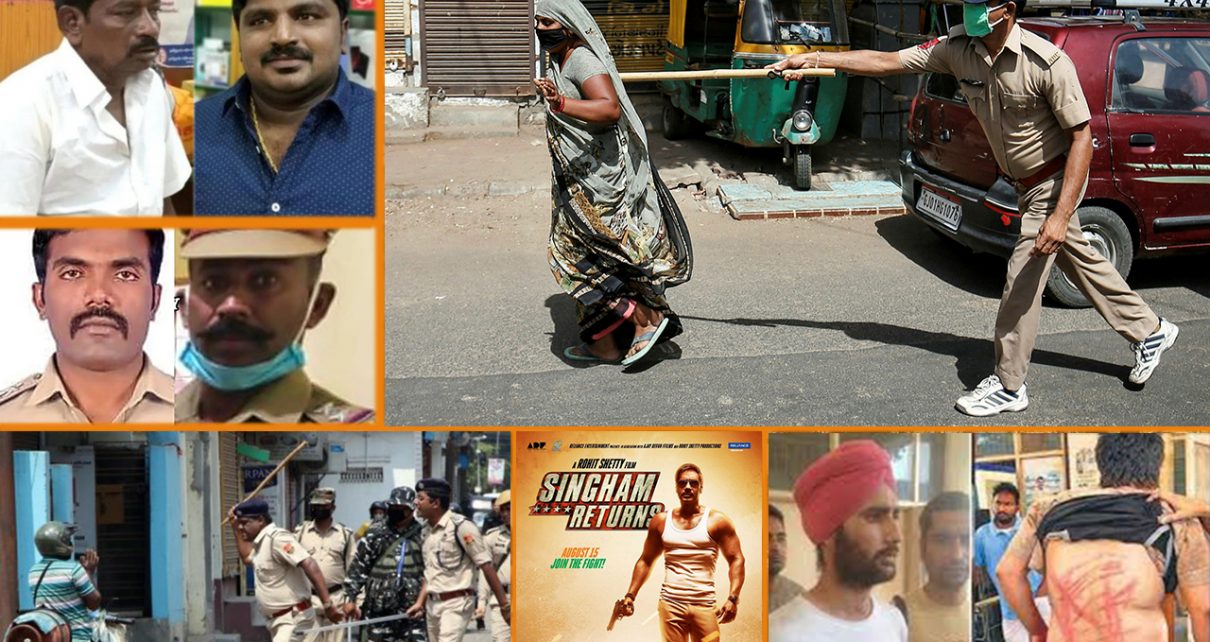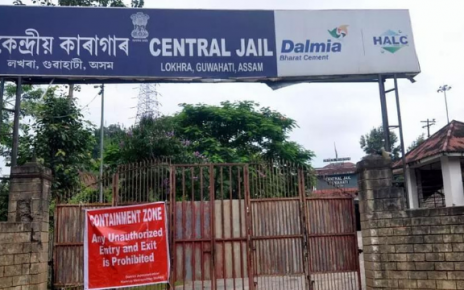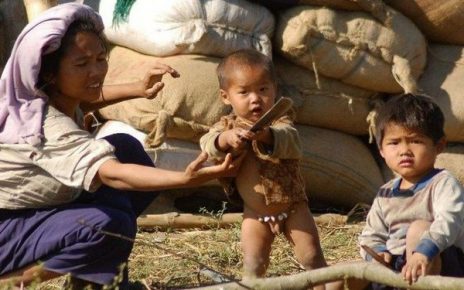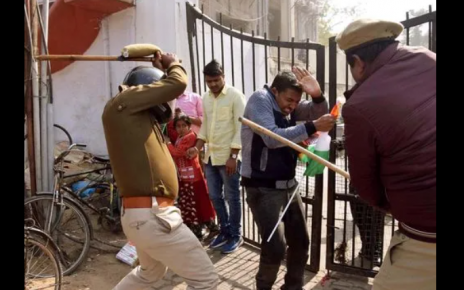Ground Xero
06 July 2020
A documentation of the custodial deaths during lockdown that also looks for the answer to some such questions around the class nature, caste nature and religious nature of such deaths. This is the second part of the Groundxero report.
The Thoothukudi murders have once again drawn our attention to custodial and other forms of violence perpetrated by the police. Although India is currently facing a public health crisis, the police have been used during this period for playing the roles of admonisher, abuser, torturer, and murderer instead of a guide that helps coordinate medical aid and other forms of relief. Although few expected otherwise, perhaps some of us have been waking up to the fact that the naked violence and apathy of the Indian administration for its citizens is not necessarily reserved for the military zones of Kashmir and the forests of Chhattisgarh and Manipur, or even the minority ghettos, that is, for the others. The deceased in Thoothukudi are after all not so different from us – the middle class Hindu. Although they are Christians, the identity of Jayaraj’s family was strongly rooted in a powerful land-owning caste. Also, unlike the migrant workers – a wide range of socio-economic-cultural-religious groups that have been artificially clubbed together into a large, faceless category during the lockdown – Jayaraj and Bennicks belonged to an established class of traders. Had it not been the case, would their deaths have prompted widespread media coverage and social media outrage? This article is a documentation of the custodial deaths during lockdown that also looks for the answer to some such questions. For the purpose we also reread some works by K. Balagopal, the late civil rights activist, who has written extensively on the subject of police and torture.
Part 1 : A trail of habitual and systematic atrocities by the Thoothukudi cops
2. Thoothukudi murders in the light of the general lockdown scenario
The murders and assaults during lockdown: Jayaraj and Bennicks from Thoothukudi were not the only victims of police violence during the lockdown. According to a report in The Wire on June 10, the National Human Rights Commission (NHRC) asked 8 states for reports on the 15 recorded deaths at the hands of the police during lockdown. Out of these 15, 12 were beaten/caned by the police on the road and three were beaten to death in police custody as a punishment for stepping out during lockdown (a rule implemented, as the government would like us to believe, for saving lives). Out of the 12, 9 succumbed to their injuries, which means, even if not beaten as spectacularly as Jayaraj and Bennicks in Thoothukudi, the beatings were severe enough. The rest committed suicide, which is generally not addressed in the mainstream media or social media as a tragedy unless committed by celebrities. About the victims, the report says:
The civil rights group said the deceased “came from weaker socio-economic sections – five were daily wage workers, one farmer, one driver, and one vegetable vendor.” Stating that most of these were “income-earning members”, the complaint had also noted that four of them were Muslims, at least two were Dalits, and one tribal. It said six of those killed were between the ages of 18 and 22 while three were above 50 years of age.
The range of victims of the rampant police brutality during the lockdown covers migrant workers, workers protesting against companies for their rights, delivery persons, vendors (despite being legally allowed to function), small traders like Bennicks and Jayaraj, people on their way to buy groceries or seek medical help, and even doctors trying to go to the hospitals. As for the vendors, not only were they beaten up and humiliated, in certain cases their commodities were dumped and ruined, causing them great financial loss on top of the economic crisis they were going through during lockdown.
Custodial murders and assaults in India in general: After Jayaraj and Bennicks’ custodial death, a lot of data on custodial death has been coming out in the media. According to an article summarizing the report (26 June 2020) of the National Campaign Against Torture (NCAT), a total of 1731 persons died in custody in the year 2019. To put this in perspective, that is, five deaths a day, out of which 125 were in police custody and the rest in jail custody. In custodial killing, Uttar Pradesh is in the lead, and is closely followed by Tamil Nadu, Punjab, Bihar, Madhya Pradesh, Gujarat etc. According to Mr. Paritosh Chakma, Director, NCAT:
Out of the 125 deaths in police custody, 75 persons or 60% belonged to the poor and marginalised communities. These included 13 victims from Dalit and tribal communities, 15 victims belonged to Muslim minority community, 37 victims were picked up for petty crimes such as theft/ burglary/ cheating/ selling of liquor illegally, gambling, etc. which indicate their economic status, three were farmers, one was labourer, one was a refugee, two were security guards, one was a rag-picker and two worked as drivers.
Let us concentrate on Tamil Nadu – the state of residence of Jayaraj and Bennicks. We may remember that one of the most horrifying aspects of the Sathankulam police included the brutality of their torture as well as their act of assault on a minor. In that context, it is significant to note that according to the NCAT report, only during the year 2019, the Tamil Nadu police has subjected at least three other minors and several youths to custodial torture which led to their deaths. The cases involving the minors are:
- Torturing a 17 year old to death to extract a confession of petty theft and cremating his body without post-mortem (Madurai);
- Pricking needles into the body of a 13 year old in connection with the illegal arrest of his brother, a 24 year old fisherman named Vijayrajan, who was chained and tortured to death in the police custody (Thanjavur);
- Branding a 13 year old with hot iron in connection with the same case as above; the minors and the deceased adult were also subjected to casteist remarks (Thanjavur).
Each of the 11 reported custodial deaths in Tamil Nadu in 2019 were often preceded by arrests without completion of the requisite formalities and were followed by days of custodial torture. This includes the death of a Dalit woman and Irula Adivasis – each death as brutal as the rest. There were just 3 Magisterial enquiries and 0 convictions of the police for these 12 cases. It is in such a context that we must evaluate Jayaraj and Bennicks’ death and not as an isolated case of horror.
We’ll keep the matter of arrests and false charges against the anti-CAA protesters out of this article, though we must make a mental note of it in this context as it provides important observations as to how police were used by the ruling party to take advantage of a moment of crisis and push its communal agenda.
Government’s failure: The BJP government’s colossal failure and lack of concern for everything other than its communal agenda and corporate nepotism have reached a new high during lockdown: starting from the delay in response to the virus despite prior information, to the testing-kit controversies, to the mismanagement of PPEs, to an unplanned lockdown thrust upon the country, to the collapse of the medical support system, to the zero transparency of the PM Cares fund, to the (much belated) PDS and Shramik train mismanagement, to its buckling under the pressure of the threat issued by the US regarding the hydroxychloroquine drug, to the recent corona drug controversy and so on. Other than some fake insincere blabbering about seeking forgiveness from his countrymen (for killing them), there has been no acknowledgment from the Prime Minister of the merciless thrashing of people by the police. In some states such as Telangana, the government itself threatened to shoot the lockdown ‘violators’ on sight. The lockdown has offered a large faction of India not a ‘do or die’ but a ‘die or die’ situation. Our elected representatives have become our tyrannical school teachers.
As any volunteer doing relief work during the lockdown would know, nor were the police enabled through resources or information by the government to actually guide the distressed working classes towards available relief – perhaps for the precise reason that there wasn’t any, at least not from the government Relief was clearly not the priority. This is not to say that in rarest of rare cases few police personnel did not actually try to help out of their own sense of duty and humanity.
It is relevant to point out here that at the level of both State and Center, the opposition parties have condemned the police and questioned the ruling party. However, this condemnation is a farce. None of the mainstream political parties have thought twice before unleashing the police on the working class, Dalits, Adivasis and Muslims whenever the need arose for them, as they have consistently proved for decades.
Thus, as this thorough report from the Open Global Rights shows, a failed and inept government let the violence remain the sole means to control the population while the number of virus-affected cases kept rising.
Government-corporate entente: To add to its misdoings, on one hand, the government kept amending the rules for the convenience of the corporates,[1] and on another hand, it turned a blind eye towards companies which were kept open during the lockdown despite becoming COVID-19 hotspots, allowing companies to force the workers to join work, though even those workers were harassed on their way to work by the police in some places. In particular in Tamil Nadu, the state-approved factories of Hyundai, MRF, Comstar and others were allowed to function despite breaking the lockdown guidelines and more importantly, despite becoming COVID-19 hotspots. It is in this context as well that we must evaluate the deaths of Jayaraj and Bennicks.
Let us make a note here that it has been alleged that not only that the Tamil Nadu government was sold out to the corporate houses, it was even unable to handle its own Home Department, when the CM / State Home Minister Palanisami attempted to cover up for the police in the Jayaraj-Bennicks case.
Failing judiciary: The failure of both the higher and the lower judiciary has made way for the police atrocity during lockdown. The higher judiciary, to save itself from obscure transfers and in some extreme cases murder, has these days taken to almost always act in a subservient manner. The lower judiciary on the other hand is not of much consequence and is in general disinterested / hesitant to question the police. This was seen in the action of the Sathankulam JM, who saw the grievously injured, bleeding father (who was also a diabetes patient) and son from a ‘social distance’ of at least 5 meters and directed them to the prison instead of the hospital. The doctor in charge too had noted down the injuries but hadn’t recommended hospitalization, which was crucial for saving the two lives.
Not only apathy, the lower judiciary also has no power over the police. This too was clear in the Thoothukudi case, when the investigating team led by the Kovilpatti JM was so badly intimidated by the police that they had to leave the Sathankulam police station. Such apathy and fear on behalf of the lower judiciary causes thousands of deaths in prisons all across the country. The condescending attitude of the police towards the lower judiciary is a well-known and well-discussed matter. The ineptness of the lower judiciary is also one of the justifications that the police give for having to take up the role of ‘teaching the lesson’. Balagopal addresses this in an article, strongly confronting how torture is popularly identified as a ‘judicious use of force to extract information’:
Needless to add, such notions as police teaching people lessons are alien to criminal law as it presently stands in India or any civilised country. That is supposed to be the job of the courts, but there is not a single policeman who has an ounce more of respect for the capacity of the courts to punish criminals than the most hardened criminal himself. The average policeman believes that the courts are extremely ineffective in proving and punishing the guilty. He therefore decides in the course of his investigation who is guilty, what is the moral standing of the guilt, what is the appropriate punishment to be given, and sets about doling out the punishment (converted into quanta of torture) inside the lock-up itself. A large part of custodial torture consists of punishment for undetermined guilt by unlawful force, and not the judicious use of force to extract information regarding crimes. It is only after the determination of the guilt and punishment are over that the policeman takes the suspect to court—with the air of one honouring a quaint ritual — to have his guilt and punishment determined all over again, this time by lawful means. (Whom and Why Do the Police Kill, K. Balagopal)
However, it has also been cited that the courts being closed due to the lockdown has allowed the police to have a free reign.
Pandemic laws making way for police brutality: While we are on the subject of judiciary and law, we must recall how, adding to the silence of the government towards police brutality, the Supreme Court proactively dismissed a plea for guidelines to be put in place to check police brutality. It might sound outrageous, but one must remember that the entire lockdown is a legal atrocity. While on one hand, the Centre has misused the Disaster Management Act 2005 to curtail the agency of the States, on another hand the dated colonial Epidemic Diseases Act 1897 has aided the police and the government to silence and torment the citizens from raising voice against any systemic mismanagement. A Daily-O report documents the historical saga of atrocities associated with this Act:
The Epidemic Diseases Act, 1897, with just four sections, was drafted in a rush with little or no foresight for the wide ambit of its misuse. Myron Echenberg, an accomplished scholar who wrote extensively on infectious diseases, noted that “the potential for abuse was enormous” in the Act. Even without the necessary foresight, just an observation of the law’s implementation since the 19th century makes it evident that the law has been used as a tool for abuse, oppression and tyranny. State abuse extended to public humiliation, abuse against women, public stripping and even violence against women – which led to historian David Arnold calling the Act “one of the most draconian pieces of sanitary legislation ever adopted in colonial India”.
Caste and religion: The Thoothukudi case cannot be discussed leaving caste aside. While it is a standing truth that the victims of police atrocity are mostly Muslims, Dalits and Adivasis (often Christians), this particular case seems to have resulted from the feud between two land-owning OBC castes in the area: Konars and Nadars. While Jayaraj’s family belonged to the (Christian) Nadar caste, SI Raghuganesh was a Konar – infamous for imposing caste tax on other communities and instigating Konar youths to destroy their property – as stated in a recent petition from Panchayat Presidents and trade union leaders. The extensive report by The Lede also refers to a previous (2006) case of custodial murder in the same police station committed by SI Srikumar, who belonged to the Nadar community and hence went unpunished.
The caste and economic position of the father and the son as Nadar traders might have played a major role in escalating this case against the police. But when it comes to Dalits, the Indian police, even when it is not the active violator, is unable and unwilling to contain caste atrocities. Although in Tamil Nadu alone, violations of Dalits have increased nearly five-fold during lockdown, activists say.
Religion might or might not have played a role in the Jayaraj-Bennicks case. Although we must once again note here the involvement of the RSS affiliated ‘Friends of Police‘ volunteers in the brutal beating. A report in Indian Legal Live describes it as: ‘The method adopted by them is akin to communal lynching in the north, only more gruesome’. Incidentally Seva Bharathi also engaged in providing relief to migrant workers in Tamil Nadu, relentlessly communalizing whenever they found the opportunity.
We may also remember that the Sathankulam SIs had earlier this year acted on a complaint lodged by a local flag bearer of the Hindutva politics – a BJP member – and beat up 9 pastors. In general, Tamil Christians, although no strangers to religious and police violence (especially Dalit Christians, from both the angles of caste and religion), have been facing an increasing number of brutal attacks since BJP came to power and allied with the already brahminically inclined AIADMK. This includes the mysterious murder of a pastor after he was threatened by Hindutva hardliners. A Catholic Father spoke to the UCA News in the context of a protest that took place after the murder and at least 14 other cases of atrocities that took place in the first quarter of April 2018 in TN:
The priest said a lack of strong political leadership in the state remains a major issue. Tamil Nadu is not ruled by the pro-Hindu Bharatiya Janata Party (BJP). But the local political party — named All India Anna Dravida Munnetra Kazhagam — which runs the government “is depending on the BJP for policy and advice on the affairs of the state. Naturally, the local Hindu forces feel emboldened to attack Christians,”
The fact that the BJP-RSS are rapidly sneaking into Tamil Nadu was proved once again recently, when the mindless Hindutva hardliners – not content to solely blaming the Muslims for the pandemic, disrupted the burial of a coronavirus-affected Roman Catholic doctor in Chennai by throwing stones. Naturally, the hate politics would catch on well with the police force that comprises mostly upper caste, land-owning Hindus.
Hypermasculine culture: The NIE article on the Kovilpatti JM’s and his team’s fateful visit of the Sathankulam police station states how the ASP and DSP in Sathankulam police station made no acknowledgment of the presence of the investigation team and instead the ASP “flexed his muscles and biceps”!
Like caste and religion, the muscle-flexing hypermasculinity ingrained in Indian culture plays a very important role in shaping the behaviour, in particular custodial behaviour, of the Indian police. Let us not go into the severely underreported (and unpunished) statistics (from NCRB, NCAT, PUDR, PUCL etc.) of custodial rape, curative rape (rape as punishment) and millions of cases of sexual harassment, molestation and humiliation committed by the police. But let us note that the reports are still primarily concentrated around the rapes committed against women.
But custodial rape, molestation and other forms of sexual violence on men by the police are not infrequent. Jayaraj and Bennicks were victims of rape as well as mutilation of genitals and anus.The punitive connotation of a man undergoing rape in police custody is similar but not the same as the custodial rape of a woman. In the case of the male victim, the homophobic police expects him to feel debased as he has been demoted to the level of a woman.
As many have discussed during the last few days, Indian films often play an important role in glorifying the hegemonic heteromasculine police: the Dirty Harry. Though the director of the famous police-movie Singham has been quick to apologize, the disease has already spread too deep within.
Part 3 : How do we react? What do we react to?
- Cancelling Shramik trains despite the deaths of the walking workers and their family;
- allowing rentiers to collect their rent while revoking the govt.’s own decision that the companies pay their workers during the lockdown period followed by an SC order;
- using police to forcefully hold workers within the company campus, despite severe inconveniences;
- further diluting the labour laws including enhancing the working hours;
- overlooking the increasing number of fatal factory mishaps, which are equivalent to murders etc.




